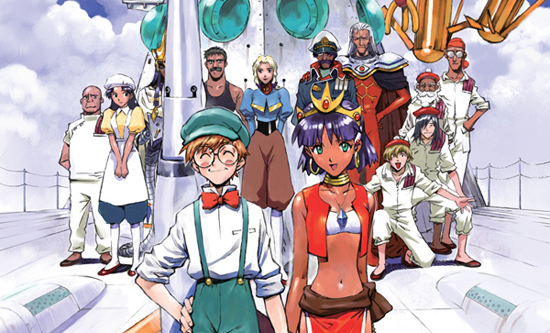
Before Panty & Stocking with Garter Belt pushed the boundaries of good taste, before Tengen Toppa Gurren Lagann redefined struggle on a cosmic scale, even before Neon Genesis Evangelion rewrote the rules of the mecha subgenre, a studio of fans-turned-animators known as Gainax made waves with Nadia: The Secret of Blue Water. Loosely based on Twenty Thousand Leagues under the Sea by Jules Verne, inspired by an unproduced story concept from Hayao Miyazaki, and helmed by series director Hideaki Anno, Nadia is a tale of high adventure set in a fantastical version of Europe and the Atlantic Ocean during the year 1889.

The series chronicles the exploits of Jean, a French boy who also happens to be an ingenious inventor, and Nadia, a young circus performer with a mysterious past. Together they seek to return Nadia to her native land, but this task is difficult since Nadia has no memories of her life before the circus. During their quest, Nadia and Jean run afoul of Grandis Granba, a wicked noblewoman with a pair of bumbling henchmen and an amphibious flying tank. Grandis covets Nadia’s Blue Water gem and will stop at nothing to possess it. Jean and Nadia also cross paths with Neo-Atlantis, a shadowy organization bent on world domination. With the aid of Captain Nemo and the crew of the Nautilus submarine, will Nadia finally discover the truth of her origins? And what is the secret of the Blue Water, the enigmatic bauble that glows whenever danger threatens Nadia?
Nadia is a show with two identities: on one hand, it’s a children’s adventure story complete with an annoying animal sidekick and a buffoonish trio of antagonists straight out of the Time Bokan animation series. On the other hand, it’s a surprisingly dark and somber proto-steampunk fantasy that leans heavily on the anticolonial and antiwar themes expressed in Jules Verne’s original novel. On the one hand, Jean is a mechanical genius whose whimsical gadgets invariably break down in a puff of cartoon smoke. On the other hand, the technology employed by Neo-Atlantis sinks ships and orphans children. In one breath, a sailor trapped in a damaged section of the Nautilus heroically accepts his fate. In the next, he screams over the intercom that he doesn’t want to die, pleading for a rescue that even he knows to be impossible. The closest comparison I can make is to Hayao Miyazaki’s Castle in the Sky, a film with which Nadia shares a similar aesthetic and tone.

Nowhere is this contrast of styles more apparent than in the dreaded “island episodes,” which were created during the final third of the series to answer the demand for more content during Nadia’s initial NHK broadcast. During the island episodes both the storytelling and the animation quality of the show take a turn for the terrible. To borrow a metaphor from another nautical work of fiction, this sequence of episodes is an albatross chained to the neck of an otherwise excellent series.
Nadia: The Secret of Blue Water has had a rocky release history in the United States. During the VHS era, Streamline Pictures released eight English-dubbed episodes of Nadia. This version is noteworthy only for the quality of the dubbing, which I’ve often heard  described as “infamous.” Many years later, ADV Films attempted to publish Nadia via a subscription-based model under their ill-fated ADV Fansubs label. Then in 2001 and 2002, ADV published a general release that spread 39 episodes across 10 individual DVDs, none of which were labeled by volume number. Perhaps as a result of this treatment, Nadia never achieved an American following like later Gainax shows did.
described as “infamous.” Many years later, ADV Films attempted to publish Nadia via a subscription-based model under their ill-fated ADV Fansubs label. Then in 2001 and 2002, ADV published a general release that spread 39 episodes across 10 individual DVDs, none of which were labeled by volume number. Perhaps as a result of this treatment, Nadia never achieved an American following like later Gainax shows did.
Now Sentai Filmworks, one of the orphans of ADV Films, is rereleasing the show in complete collections on Blu-ray and DVD. Hopefully this release will receive the attention it merits, because although it’s been eclipsed by the popularity and influence of Evangelion, Nadia: The Secret of Blue Water is nevertheless a highwater mark for anime from an earlier era. Recommended.
This story was originally published in the April 2014 issue of Otaku USA Magazine.







